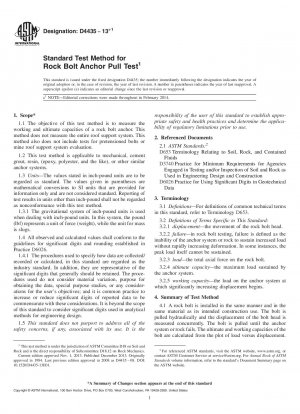ASTM D4435-13e1
Standard Test Method for Rock Bolt Anchor Pull Test
- Standard No.
- ASTM D4435-13e1
- Release Date
- 2013
- Published By
- American Society for Testing and Materials (ASTM)
- Latest
- ASTM D4435-13e1
- Scope
5.1 Rock bolts are used for support in a variety of mining and civil engineering situations.3 The pull test may be used to provide a quantitative measure of the relative performance of different anchor systems in the same rock type. Anchor systems may be different mechanical anchors or different bond materials or lengths for grouted anchors. Such data can be used to choose an anchor type and determine bolt length, spacing, and size.
5.2 The objective of the method is to measure anchor performance, and not the performance of the rock bolt itself. Thus, to make sure the bolt response during the test is minimal and predictable, high strength, short-length (6 to 8 ft (1.8 to 2.5 m)) bolts have been specified. The bolt should be just long enough to make sure that failure occurs in the anchor system and not from the reaction pad bearing down on the rock mass.
5.3 Ideally, the rock bolt anchor should fail by shear at the anchor-rock interface or bond. Therefore, the local characteristics of the rock, such as roughness and induced fractures, are significant factors in the anchor strength. To obtain realistic strength values, the test holes should be drilled using the same methods as the construction rock bolt holes.
5.4 Rocks with significant time-dependent behavior, such as rock salt or shale, may respond to the anchor system itself and change the anchor strength. In these cases, consideration should be given to testing bolts over a period of time.
5.5 In establishing a testing program, the following factors should be considered:
5.5.1 Anchor pull tests should be conducted in all rock types in which construction bolts will be installed. If the rock is anisotropic, for example, bedded or schistose, the tests should be conducted in various orientations relative to the anisotropy, including those at which the construction bolt may be installed.
5.5.2 In each rock type, at each orientation, and for each anchor system, a sufficient number of tests should be conducted to determine the average bolt capacities within a fixed uncertainty at the 958201;% confidence level. The allowable uncertainty band depends on the project and involves such factors as the rock quality, expected project lifetime, and importance of the areas to be bolted. Its determination will require considerable engineering judgment. As a rough guideline, at least 10 to 12 pull tests for a single set of variables have been found necessary to satisfy the statistical requirements.
Note 1—The quality of the result produced by this standard is dependent on the competence of the personnel performing it, and the suitability of the equipment and facilities used. Agencies that meet the criteria of Practice D3740 are generally considered capable of competent and objective testing. Users of this test method are cautioned that compliance with Practice D3740 does not in itself assure reliable results. Reliable results depend on many factors; Practice D3740 provides a means of evaluating some of those factors.1.1 The objective of this test method is to measure the working and ultimate capacities of a rock bolt anchor. This method does not measure the entire roof support system. This method also does not include tests for pretensioned bolts or mine roof support system evaluation.
ASTM D4435-13e1 Referenced Document
- ASTM D3740 Standard Practice for Minimum Requirements for Agencies Engaged in the Testing and/or Inspection of Soil and Rock as Used in Engineering Design and Construction
- ASTM D6026 Standard Practice for Using Significant Digits in Geotechnical Data
- ASTM D653 Standard Terminology Relating to Soil, Rock, and Contained Fluids
ASTM D4435-13e1 history
- 2013 ASTM D4435-13e1 Standard Test Method for Rock Bolt Anchor Pull Test
- 2013 ASTM D4435-13 Standard Test Method for Rock Bolt Anchor Pull Test
- 2008 ASTM D4435-08 Standard Test Method for Rock Bolt Anchor Pull Test
- 2004 ASTM D4435-04 Standard Test Method for Rock Bolt Anchor Pull Test
- 1984 ASTM D4435-84(1998) Standard Test Method for Rock Bolt Anchor Pull Test

Copyright ©2024 All Rights Reserved